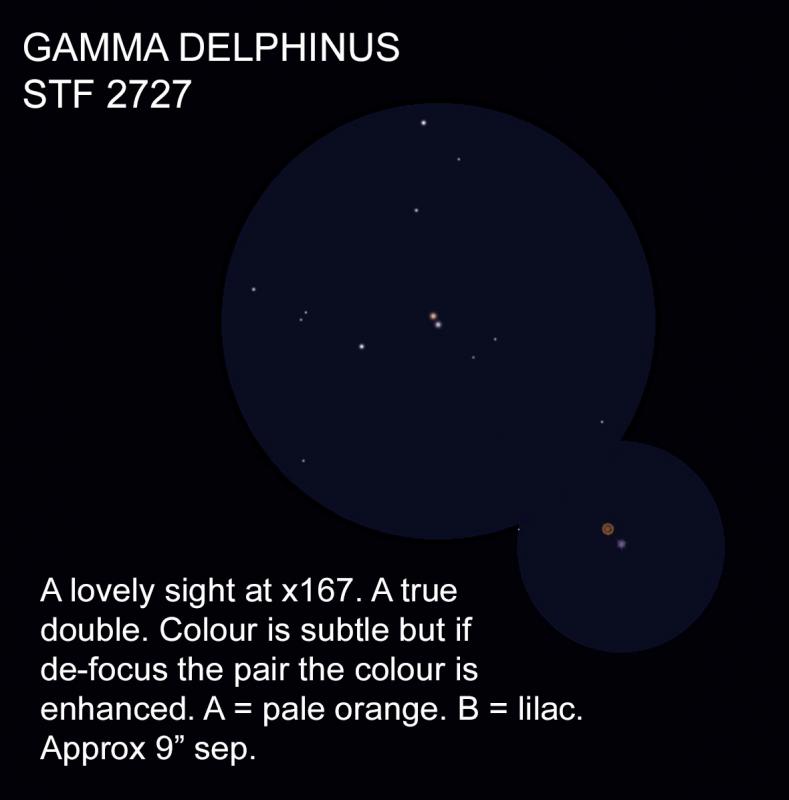2019 October 20
Observer’s Challenge – Colours of Double Stars

We are told there is no such thing as a green star. I’ve read papers, articles and heard talks on this but have never been fully convinced although I quietly accept the fact. I suppose my thoughts are subjectively ‘coloured’ by the fact I would like to see green stars, after all we have, red, orange, yellow, white and blue stars, why not green? The grass is always ‘greener’ …….
A prism splits white light into the spectral rainbow colours of:
Red Orange Yellow Green Blue Indigo Violet
Stellar classes are classified thus in keeping with blackbody radiation:
M; Orange-Red, K; Orange, G; Yellow, F; Yellow-White, A; White, B; Blue-White, O; Blue-White
So a green star if there were such a thing matches the position of stellar class A, a white star in accordance with its black-body spectrum. In fact the isolated star β Librae (Zubeneschamali, the northern claw) most commonly referred to as the only star that looks greenish is spectrum B8 (just above A0 on the stellar spectrum.)
Probably the best explanation I’ve seen on how the eye sees colour in stars as opposed to rainbow spectrum colours is explained in this Wikipedia link: https://en.wikipedia.org/wiki/Green_star_(astronomy)
To the naked eye only the brighter stars display any colour such as Betelgeuse (Orange-Red), Arcturus (Orange), Capella (Yellow) and Vega (Bluish-White) and even these are subtle. Absolute beginners at outreach gatherings sometimes struggle to note these colours and this is because primarily the eye struggles to see colour in faint objects thus most stars appear white to the naked eye. However, turn a telescope or even binoculars onto a star and their individual colours become more apparent, again because you are amplifying the light and making it easier for the eye to see colour. But the eye does not see colour as well on a point object compared to an extended object. So if you increase the size of the star image either by de-focusing or magnifying it into an airy disc the colour becomes more apparent provided of course the star was bright enough to withstand increasing its surface area and maintaining colour sensitivity in the eye.
Even though books refer to red stars or reddish I personally rarely see a truly red star in isolation with red giants such as Antares and Betelgeuse appearing orange-red. There are exceptions such as the red giant Mira type variables; Hind’s Crimson star (R Leporis) and Mira (ω Ceti) itself. But I only see them as ‘red’ when at their fainter stages helped by the light gathering power of my 60 cm Newtonian. Another ‘red’ contender is Herschel’s Garnet star (μ Cephie).
Yellow stars I do see as yellow, ditto orange stars but Blue Giants I only see as light blue or bluish-white at best. There are no Indigo or Violet stars.
However, the situation changes when one observes coloured double stars as a contrast effect comes into play on the eye. Who has not seen the obvious colour contrast of Albireo’s yellow and blue stars, no light blue here, a definite blue. Ditto Almach (γ Andromeda) also yellow and blue. As an aside, I prefer the latter to Albireo. As mentioned before, colour is seen better if one defocuses or magnifies the star into an airy disc. But increasing the power sufficiently to achieve this separates Albireo’s (35” separation) stars so much that one loses the contrast effect whereas Almach’s pair are only 9.8” separation – much better. Another good colour contrast pair for a small telescope is Eta Cassiopeiae which look yellow and red to me.
When one see’s what would be a whitish star next to an orange-red giant the contrast effect on the eye makes them appear red and green. A well-known example of this is Rasalgethi (α Herculis) a variable (mag 3 to mag 4) M5 reddish supergiant and a mag 5.4 fainter companion actually made up of a G5 star and a F2 star separated by only 0.4AU. The contrast effect being that the main pair appear reddish (or orange-red) and green. Unfortunately Rasalgethi will be a bit low to observe well by the time this article appears so for this challenge I have chosen γ Delphinus. This star will still be at an altitude of 50 degrees by the start of astronomical dark on new moon, 26th November 2019. The primary is a mag 4.3 K1 orange subgiant, the companion a mag 5.1 yellow-white F7 main sequence star. They are separated by 8.9” so the colour contrast effect is good and I see the pair as ‘golden’ and ‘green’. Mike Wood (see his sketch attached) describes the pair as pale orange and lilac. Bob Argyle describes the pair as golden-yellow and blue-green. Admiral Smythe described yellow and light emerald. Rev T.W. Webb described gold and bluish green or yellow and pale green. Re the latter two Victorian amateur double star observers note that they invariably used longish focal length achromatic refractors which themselves introduce false colour and can affect the subjective perception of colours observed. It should also be borne in mind that individual people perceive colours differently so perhaps no two people looking at a coloured double see exactly the same colours.

So, what colours do you see? It should be borne in mind that different apertures of telescope will have an effect, also the type of telescope; reflector, achromatic refractor or apochromatic refractor. Another factor is the amount of any moonlight present, ideally observe in a fully dark sky.
Please do submit any observations to your BAA Member Page and to the Deep Sky Section.
| The British Astronomical Association supports amateur astronomers around the UK and the rest of the world. Find out more about the BAA or join us. |
